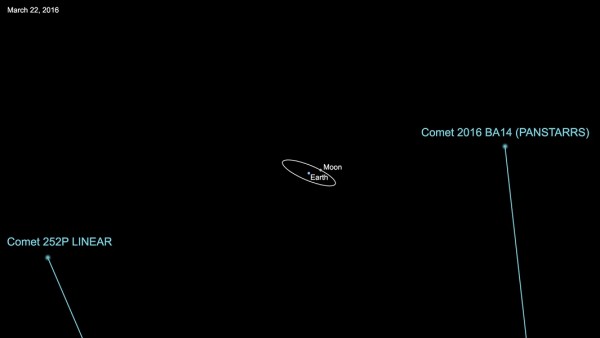By Ana Verayo, | March 20, 2016

Comet 252P/LINEAR will safely fly past Earth on March 21, 2016, at a range of about 3.3 million miles (5.2 million kilometers). The following day, comet P/2016 BA14 will safely fly by our planet at a distance of about 2.2 million miles (3.5 million kilome
This week, Earth will be visited by two comets which will be one of the planet's closest encounters ever recorded. According to NASA's Center of NEO (Near Earth Objects) Studies at the Jet Propulsion Laboratory in California, these two comets following each other will arrive early this week, some 2.2 to 3.3 million miles away from Earth.
Like Us on Facebook
Astronomers also announced that even if these two "twin" comets will zip by remarkably close to Earth, they will still pass by safely. Since record keeping began, the closest comet to ever come by Earth is known as Lexell's Comet or comet D/1770 L1 that is named after a Finnish Swedish astronomer Anders Johan Lexell, where the comet almost grazed the planet by 1.4 miles when it passed by in 1770.
Astronomers are expecting to see that the first comet, known as 252P/LINEAR measuring 750 feet wide, will visit Earth's backyard on March 21, Monday at a close range of 3.3 million miles, which is the third closest recorded comet to ever get near the planet. The next day, Comet P/2016 BA14 will arrive, which is double the size of 252P/LINEAR at a distance of 2.2 million miles.
On March 21, the closest approach of comet 252P/LINEAR will be around 8:14 A.M. EDT while the closest approach of P/2016 BA14 will happen around 10:30 A.M. EDT the next day. Since both comets will fly by from relatively close distances, for those who want to get a glimpse of them, they will still need professional telescopes due to their small sizes.
According to the manger of NASA CNEOS, Paul Chodas, the approach of BA14 is so close that it will become the closest comet to ever visit Earth in the next 150 years. He also adds that this comet is not a threat, but this can be a very excellent opportunity for scientific advancement in the study of comets.
Chodas adds that the orbits of these two comets are so remarkably similar to each other that astronomers are now in the race to determine if the two space rocks originate from the same source or are related in any way with each other.
Further observations from the Hubble Space Telescope and NASA's Infrared Telescope Facility are needed to investigate their true nature.
Chodas believes that since comets are relatively fragile space objects, pieces and fragments could form a comet puzzle. For example, the comet Shoemaker-Levy 9 was discovered to originate from pieces linked from a Jupiter flyby and now, perhaps these two are remnants from a prior pass from the inner solar system where either one could have been a part of a larger object.
-
Use of Coronavirus Pandemic Drones Raises Privacy Concerns: Drones Spread Fear, Local Officials Say

-
Coronavirus Hampers The Delivery Of Lockheed Martin F-35 Stealth Fighters For 2020

-
Instagram Speeds Up Plans to Add Account Memorialization Feature Due to COVID-19 Deaths

-
NASA: Perseverance Plans to Bring 'Mars Rock' to Earth in 2031

-
600 Dead And 3,000 In The Hospital as Iranians Believed Drinking High-Concentrations of Alcohol Can Cure The Coronavirus

-
600 Dead And 3,000 In The Hospital as Iranians Believed Drinking High-Concentrations of Alcohol Can Cure The Coronavirus

-
COVID-19: Doctors, Nurses Use Virtual Reality to Learn New Skills in Treating Coronavirus Patients







